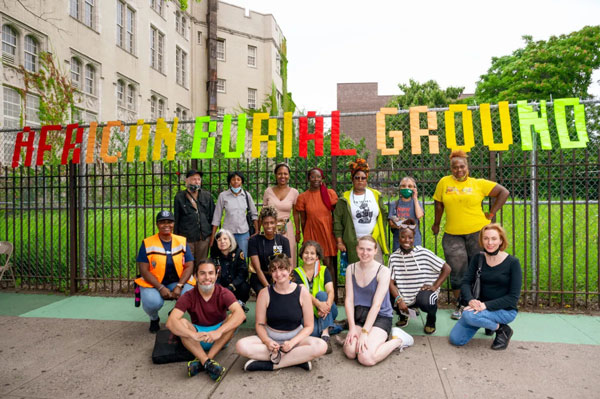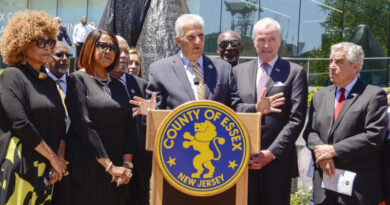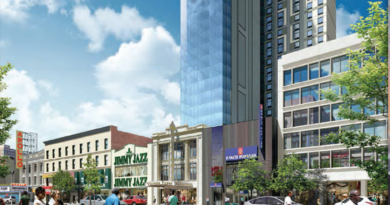Flatbush African Burial Ground
By Glenda Cadogan
GPS coordinates to Eve’s Garden will most likely take you to a specialty store in Midtown Manhattan. Conversely, if you journey to the Flatbush section of Brooklyn and ask for directions to Eve’s Garden you’ll be led to the corner of Bedford and Church Avenues, the site of the sacred African Burial Ground currently at the center of heated opposition between community activists and politicians.
Human remains of Africans and other artifacts discovered in 2001 during an archeological exploration are at the heart of the matter.
Leading the charge against the desecration of the unmarked “slave” cemetery is African Graves Matter (AGM) an organization founded by the late community activist and political aspirant Harriet Hines. Hines, well known for her many social justice projects, died unexpectedly in late April sending shock waves through the activist community. Dr. Jackie Cody, chair of the Education Committee of the National Action Network took over the charge along with AGM Co-Founder Rev. Gregory Seal Livingston.
“The African Burial Ground is a site of great cultural and national significance,” Dr. Cody explained. “It needs to be preserved for the education of our children as well as to honor our ancestors who built this land. To desecrate it will be a grave injustice to our history and our future.”
The community outrage ignited in October of 2020 when then New York City Mayor Bill de Blasio and the area’s former Council member representative Mathieu Eugene announced plans to build a housing complex at the vacant site at 2286 Church Avenue just behind Erasmus Hall High School. The site itself has a colored history. A Jewish School on the property was demolished in 2015 due to structural hazards. This led spiritual skeptics to suggest that desecrated Africans “turning in their graves.”
Superstitious beliefs aside, it is largely agreed that to build anything other than a monument or museum on top of the bones of enslaved Africans is a disgrace of a high seismic magnitude. The ad hoc burial ground is connected to the Flatbush Reformed Church (formerly the Dutch Reformed Church built in 1654) situated one block away, itself a landmark location. According to historians, African progenitors who built the Church were deemed unfit to be buried at its adjacent cemetery with former colonizers and slave holding families the likes of the Vanderbilts, Lefferts and Livingstons. Instead they were discarded “like chicken bones” a block away.

On the invitation of Hines, Rev. Livingston a recent transplant from Chicago, joined the movement (then known as the #1654Coalition). Well versed in community activism in the Windy City, Rev. Livingston propagates an action he calls “redistributing the pain. It was clear that in order for other people to feel what we feel when you disrespect our ancestors, we needed to take some physical action like protests. It’s kind of like the doctor who has to hurt you to help you,” he explained. By that time several other groups were working on saving the site with weekly community clean ups and awareness actions. Rev. Livingston and company turned up the heat by taking to the streets in demonstrations at Brooklyn Borough Hall and in front of the Reformed Church. “I remember one police officer coming up to me and saying, ‘you cannot block Flatbush and Church Avenue. This is one of the busiest intersections in Brooklyn!’ I said to him: That’s exactly why we are here.”
Rev. Livingston, described AGM as being at the “beginning of victory. We successfully blocked the developers from starting any housing construction,
thereby taking hold of the site. But just like getting pregnant is one thing but having the baby is a whole other lifetime, we have a long way to go. We now need to have an all-Black design team come in and construct a monument similar to the one in Manhattan.”
Both sides of the divide are passionate about their arguments for the best development of the site. Some say the proposed affordable housing is a dire need in the area. But to the AGM, preservation of the site goes beyond the obvious. “The journey of Africans in America is an incredible one because we were never supposed to survive,” said Rev. Livingston. “We stand on the shoulders of these Africans who went on before us for centuries. By creating a monument to them we are teaching lessons to our young people so they can see themselves differently. We talk about Black folks always topping the list of negative indicators so one thing a monument such as this does is begin to alter this narrative to show we have the power to respect ourselves because we respect our history. Those bones are sacred.”
The struggle continues and more demonstrations are planned for Brooklyn as efforts to protect sacred African burial sites gain momentum all over the nation. The political support for the cause is coming from US Senator Sherrod Brown and Congresswoman Alma Adams who have tabled bills at the federal level. The African American Burial Grounds Preservation Act is designed to stop the desecration of African burial grounds and cemeteries nationwide by designating them as national sites.
To many, the unknown dark skinned enslaved woman for whom the site is affectionately named is Brooklyn Mitochondrial Eve. She is representative of the grandmothers who picked cotton in the south and the mothers who did the same on the sugarcane plantations in the Caribbean. However, she was not “a slave” as the colonizers would have us believe. But rather, she was quite possibly a queen who was enslaved. And like the great African matriarchs of history she had a heart of gold and a soul. In this way she–like all other Africans interred at 2286 Church Avenue–are reminders that in the struggle for self-determination Black Lives Matter. So too it’s important to remember that Black souls matter. A luta continua!


